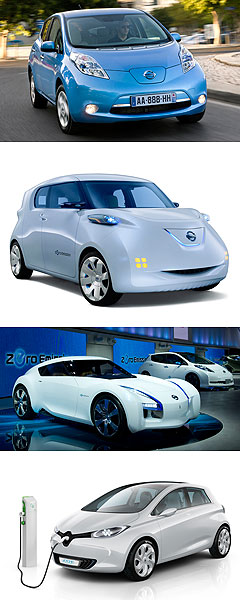Make / Model Search
News - NissanRenault-Nissan alliance sets 1.5m EV target by 2016Ghosn green: Nissan CEO Carlos Ghosn (pictured with the Pivo EV concept) wants electric vehicles to become mainstream rather than niche Electrification goals set out in Renault-Nissan push toward zero-emission motoring7 Dec 2011 By BYRON MATHIOUDAKIS in TOKYO NISSAN has announced that – along with alliance partner Renault – it aims to sell up to 1.5 million EV electric vehicles worldwide by March 31 2017, the end of its 2016 financial year. Dubbed Nissan Green Program 2016 (NGP2016), the strategy takes in new hybrid, pure-electric and fuel cell vehicles over the next five years, in order to reduce carbon dioxide emissions by 20 per cent compared to 2005/6 levels, on the way to an 80 per cent cut by 2050. A fall in natural resource usage from 80 per cent today to 75 per cent in 2016 and then 30 per cent in 40 years’ time is Nissan’s long-term vision. The NGP2016 plan – which also includes an all-new CVT transmission specifically designed for petrol/electric hybrid drivetrains beginning with next year’s US Altima – has come about as Nissan believes the internal combustion engine is reaching its technical limit in terms of reducing consumption and emissions. The aim is to move EVs from the fringes to mass-market acceptance, as the unit price for expensive parts like the lithium-ion batteries falls while the worldwide infrastructure needed to serve electrification improves.  From top: Nissan Leaf, Townpod, Esflow and Renault Zoe concept. From top: Nissan Leaf, Townpod, Esflow and Renault Zoe concept.It is the natural follow-up to the firm’s NGP2010 strategy, which gave rise to the Leaf EV. Nissan says it is currently holding almost 20,000 orders, making the five-seat five-door hatchback the most successful electric car in history. That will be joined by three more pure EVs introduced before April 2017 – said to be an Infiniti-based C-segment luxury car in the mould of the upcoming Audi A3 e-tron, a zero-emissions commercial vehicle and a sports car. Nissan may also be investigating a battery-powered city-car based on the Renault Zoe hatch to be unveiled next year. It has already previewed several Pivo concept cars that fit this bill at the Tokyo motor show since 2005. Aiding the acceptance of these EVs will be new wireless charging technology available in homes, workplaces and public parking spaces as an alternative to heavy and cumbersome cables. Nissan says wireless charging stations are waterproof and safe in the event of accidental contact while being only about five to 10 per cent less efficient than conventional cable-based systems. Improved fast charging technology and infrastructure is also coming, as is an in-vehicle ‘discharge’ system that can feed electricity back into the grid during peak times or provide power to homes should the need arise. Meanwhile, a fuel cell vehicle (FCV) developed in conjunction with Daimler as part of a technology and model-sharing program announced two years ago is vital to the NGP2016 plan. It is confirmation that Nissan’s first hydrogen-powered FCV will enable it to join Toyota in hitting the market within the next five years, although there is no word yet as to whether Australia will see such a vehicle in that time frame. Key to Nissan’s FCV is its latest fuel cell stack system unveiled in October, featuring an 85kW output in a package that is 2.5 times smaller and just one-third of the weight of the item it previewed in a 2005 X-Trail-based FCV. Making vehicles lighter in the future, too, is vital to the development of EVs, with Nissan already announcing a big increase in the use of ultra-high-tensile steels. According to Nissan CEO Carlos Ghosn, NGP2016 aims to make EVs the norm, not the exception. “The next challenge is making (the Leaf) a mass marketing success and making the electric car the obvious choice for consumers. And not just the Leaf, but also three other vehicles that are coming… we don’t want to make the electric car something that is just niche,” he said. Finally, NGP2016 will also strive to provide energy storage solutions once used EV batteries become commonplace, as part of a ‘second-life’ strategy that calls for their reuse, re-fabrication, reselling and recycling.  Read more6th of December 2011  Nissan’s two-speed design philosophyBold is in at Nissan – except for icons like GT-R, Zed and now Dualis6th of December 2011  NV350 set to spearhead Nissan’s van returnNissan focuses on cracking the Hi-Ace/iLoad duopoly with a familiar looking van11th of November 2011  Nissan slashes cost of EV fast chargersNew Nissan EV quick charger to hit US market at a third of the cost of current units24th of October 2011  Zoe aims to be global EV bestsellerRenault hopes its upcoming Australia-bound electric light car will be a top-seller |
Click to shareMotor industry news |











Facebook Twitter Instagram